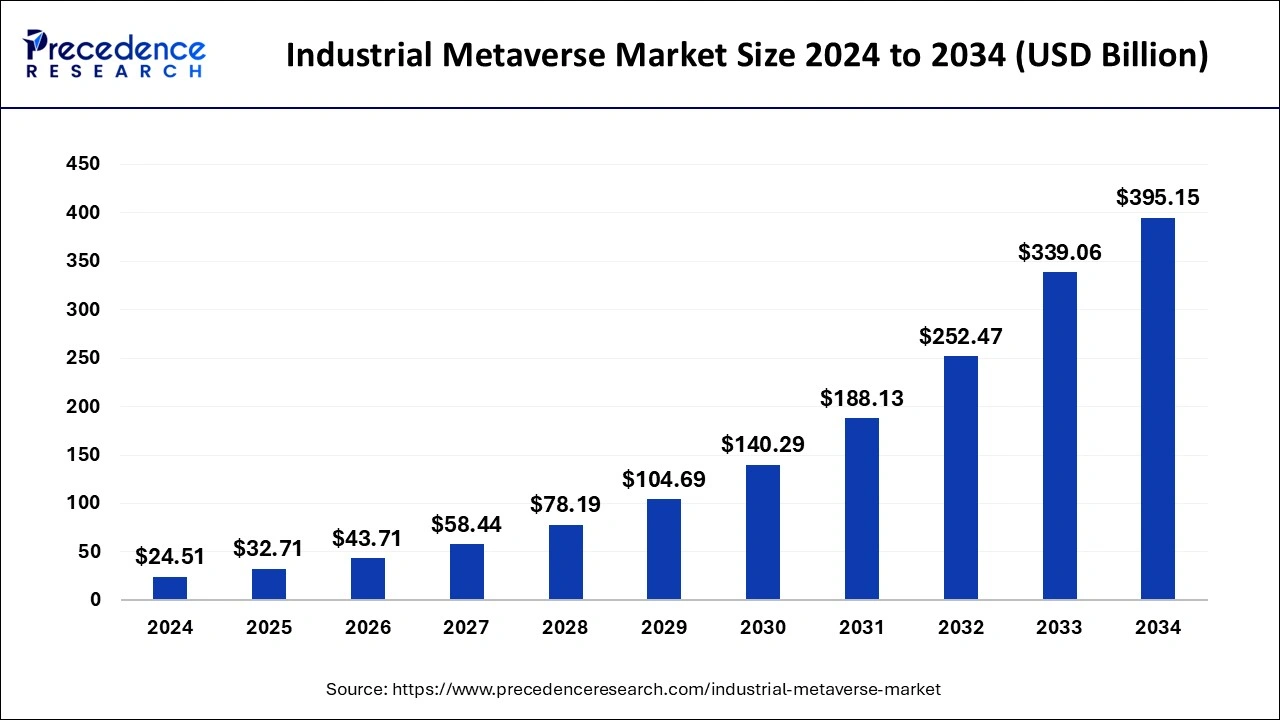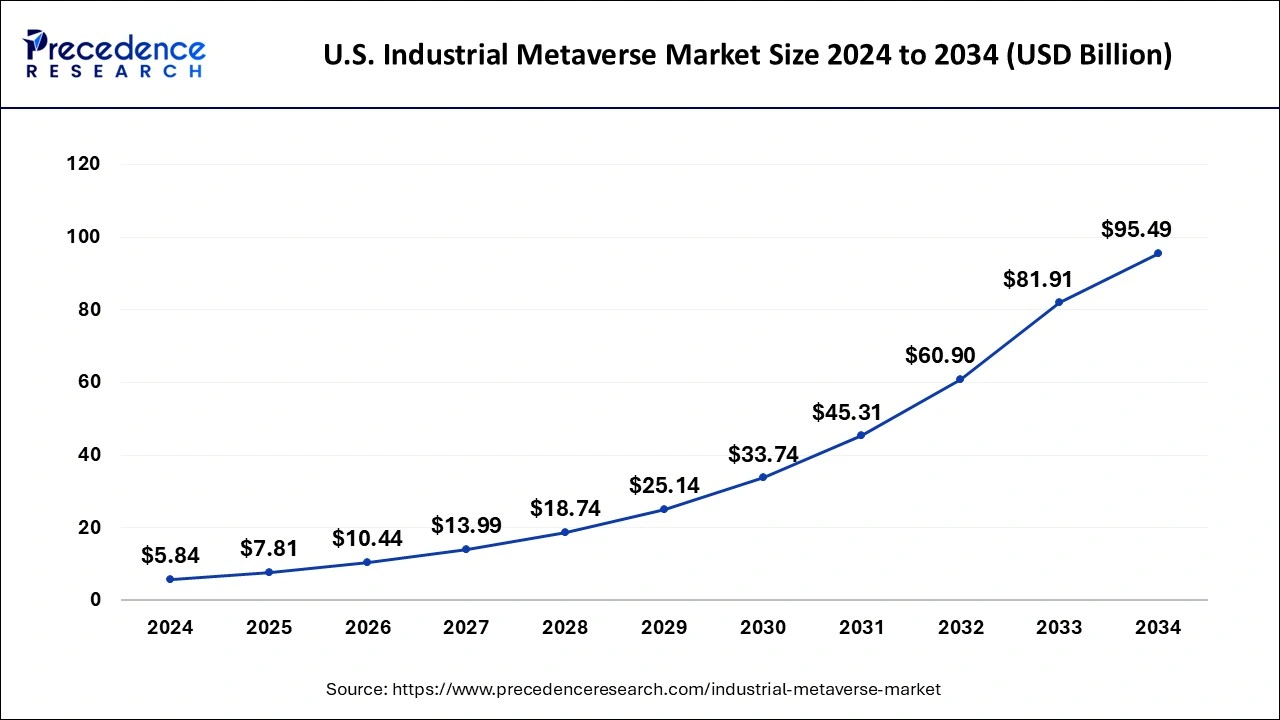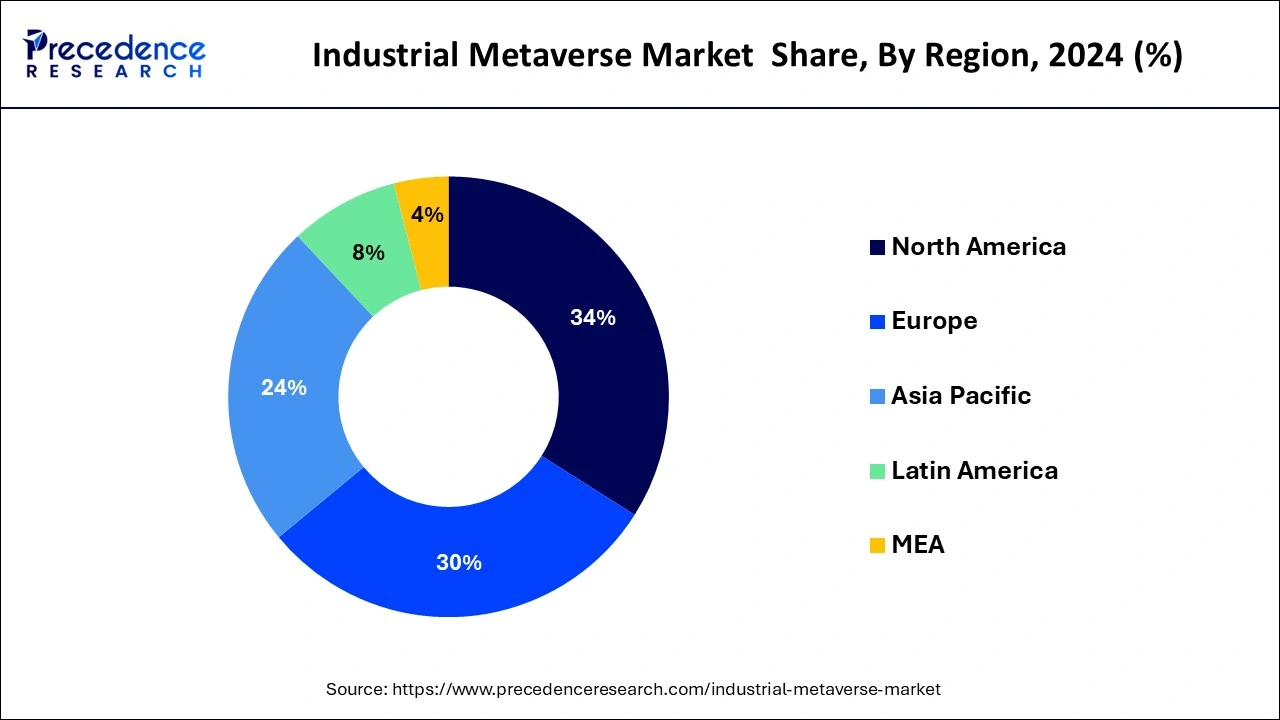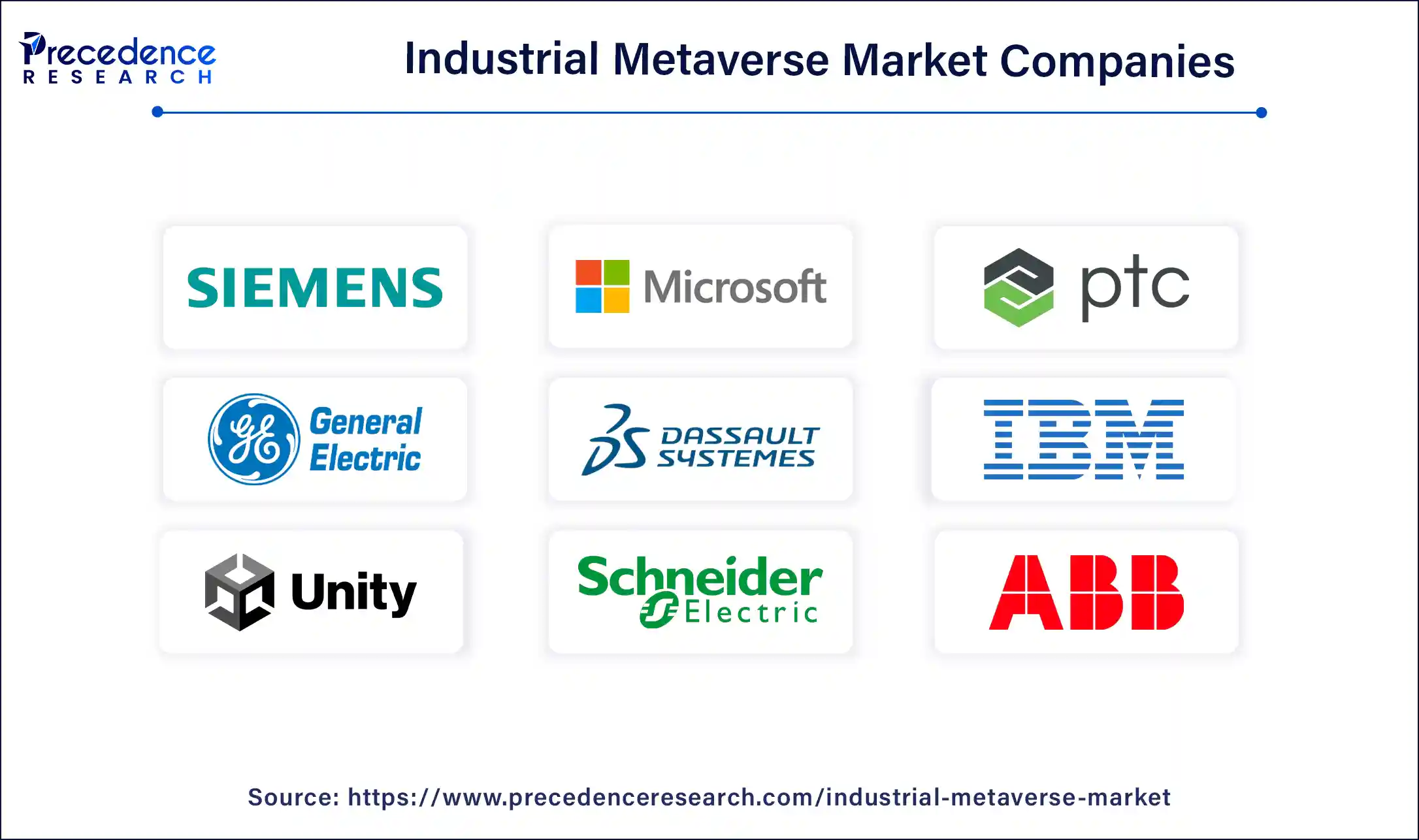March 2025
The global industrial metaverse market size is calculated at USD 32.71 billion in 2025 and is forecasted to reach around USD 395.15 billion by 2034, accelerating at a CAGR of 32.05% from 2025 to 2034. The North America industrial metaverse market size surpassed USD 8.33 billion in 2024 and is expanding at a CAGR of 32.06% during the forecast period. The market sizing and forecasts are revenue-based (USD Million/Billion), with 2024 as the base year.
The global industrial metaverse market size was valued at USD 24.51 billion in 2024 and is expected to hit around USD 395.15 billion by 2034, poised to grow at a CAGR of 32.05% from 2025 to 2034.

The U.S. industrial metaverse market size was estimated at USD 5.84 billion in 2024 and is expected to reach around USD 95.49 billion by 2034, growing at a CAGR of 32.24% from 2025 to 2034.

North America held a share of 34% in the industrial metaverse market in 2024 due to its robust technological infrastructure, widespread adoption of advanced technologies, and a high concentration of key market players. The region's proactive approach to Industry 4.0 initiatives, coupled with significant investments in research and development, has positioned it at the forefront of industrial innovation. Additionally, a mature ecosystem of technology providers, strong collaborations between industry and academia, and a favorable regulatory environment contribute to North America's dominance in driving the growth of the industrial metaverse market.

The industrial metaverse market in the Asia-Pacific region is set for rapid expansion, driven by its strong technological infrastructure, growing embrace of advanced manufacturing, and a rapidly expanding industrial sector. Leading nations like China, Japan, and South Korea are at the forefront of technological innovation, providing a solid groundwork for the seamless integration of industrial metaverse technologies. Furthermore, the region's dedicated commitment to Industry 4.0 initiatives and the increasing need for digital transformation in the manufacturing sector creates a conducive environment, establishing Asia-Pacific as a pivotal catalyst for propelling the industrial metaverse market forward.
Meanwhile, Europe is experiencing notable growth in the industrial metaverse market due to the increased adoption of advanced technologies, strong emphasis on Industry 4.0 initiatives, and a proactive approach toward digital transformation. Companies in the region are leveraging the industrial metaverse for virtualized manufacturing, collaborative design, and enhanced operational efficiency. Furthermore, supportive regulatory frameworks and strategic investments in research and development contribute to the region's prominence in harnessing the potential of the industrial metaverse, positioning Europe as a key player in the evolution of industrial practices.
The industrial metaverse represents an emerging digital terrain that integrates virtual and augmented. The industrial metaverse is a groundbreaking concept that extends the metaverse principles to the industrial realm. It acts as a virtual space where the physical and digital aspects of manufacturing seamlessly blend. This forward-thinking environment empowers manufacturers to generate digital replicas, or "twins," of their actual factories.
Utilizing technologies like augmented reality, virtual reality, artificial intelligence, and the internet of things, the industrial metaverse facilitates the visualization, analysis, and optimization of industrial processes in a collaborative and dynamic virtual setting. This integration of cutting-edge technologies holds the promise of enhancing operational efficiency, encouraging innovation, and advancing sustainability practices across diverse industrial sectors, marking a significant advancement in industrial methodologies.
| Report Coverage | Details |
| Growth Rate from 2025 to 2034 | CAGR of 32.05% |
| Global Market Size in 2025 | USD 32.71 Billion |
| Global Market Size by 2034 | USD 395.15 Billion |
| Largest Market | North America |
| Base Year | 2024 |
| Forecast Period | 2025 to 2034 |
| Segments Covered | By Component, By Application, By Technology, and By End-use |
| Regions Covered | North America, Europe, Asia-Pacific, Latin America, and Middle East & Africa |
Remote work trends
The surge in remote work trends has become a pivotal driver for the burgeoning demand in the industrial metaverse market. As organizations embrace flexible work arrangements, the need for virtualized industrial processes and remote collaboration intensifies. The industrial metaverse responds to this demand by providing immersive digital environments that enable remote monitoring, operation, and collaboration within industrial settings.
With the global shift toward decentralized workforces, companies seek solutions that enhance connectivity and efficiency, making the industrial metaverse a crucial enabler of seamless virtual collaboration. Moreover, the impact of the COVID-19 pandemic has accelerated the adoption of remote work practices, prompting industries to invest in technologies that bridge physical distances. The industrial metaverse not only addresses the challenges posed by remote work but also enhances the overall resilience and adaptability of industrial operations, fostering a dynamic and interconnected approach to manufacturing and production.
Lack of standardization
The lack of standardization poses a significant restraint on the market demand for the industrial metaverse as it hampers interoperability and hinders seamless integration across diverse industrial landscapes. Without universally accepted protocols and guidelines, companies face challenges in adopting cohesive and scalable industrial metaverse solutions. This lack of standardization results in a fragmented ecosystem where different technologies may struggle to communicate effectively, leading to inefficiencies and increased implementation complexities.
The absence of industry-wide standards not only impedes technological integration but also hampers the establishment of best practices and benchmarks. Companies may hesitate to invest in industrial metaverse technologies without clear standards, fearing potential compatibility issues and the need for costly modifications in the future. Standardization efforts are crucial for fostering confidence among businesses, streamlining adoption processes, and promoting the widespread acceptance of the industrial metaverse as a transformative tool for industrial operations.
Enhanced productivity and efficiency
The pursuit of enhanced productivity and efficiency stands as a paramount opportunity in the industrial metaverse market. By leveraging virtual simulations, real-time monitoring, and data analytics, industrial entities can streamline their workflows and achieve unprecedented levels of operational efficiency. The ability to optimize resource utilization, minimize downtime, and implement predictive maintenance through the industrial metaverse translates into tangible cost savings and improved overall productivity.
Furthermore, the industrial metaverse empowers industries to embrace innovative problem-solving and decision-making approaches. The virtualized environment facilitates swift prototyping, testing, and iteration, significantly shortening product development cycles. This acceleration not only fosters innovation but also positions companies competitively in dynamic markets. The profound impact of heightened productivity and efficiency establishes the industrial metaverse as a pivotal player in the advancement of industrial practices, offering substantial economic benefits and fostering a culture of continual improvement within the market.
The hardware segment held the highest market share of 43% in 2024. Within the industrial metaverse market, the hardware segment encompasses the tangible elements forming the bedrock for immersive interactions. This comprises augmented reality and virtual reality headsets, alongside sensors and haptic feedback devices. A notable trend in this sector involves the evolution towards more streamlined and user-centric devices, enhancing accessibility and user comfort in industrial settings. Moreover, continuous enhancements in hardware specifications, including heightened processing capabilities and superior display resolutions, contribute to a heightened level of realism and immersion within the industrial metaverse experience.
The service segment is anticipated to witness rapid growth at a significant CAGR of 36.16% during the projected period. In the industrial metaverse market, the "service" segment encompasses a range of offerings that support the implementation, customization, and maintenance of virtualized industrial solutions. These services often include consultancy, training, and technical support to ensure seamless integration and optimal performance. A notable trend in this segment is the growing demand for specialized consulting services, reflecting the need for tailored guidance in navigating the complexities of adopting and optimizing industrial metaverse technologies, thereby maximizing the value derived from these transformative solutions.
The application, the data visualization & analytics segment has held 30% market share in 2024. The data visualization & analytics segment within the industrial metaverse market pertains to the representation and analysis of complex industrial data in a visual format. This segment involves the use of advanced tools to transform data into meaningful insights, aiding decision-making in real-time. A prominent trend in this segment is the growing demand for intuitive and interactive visualization solutions, enabling industrial stakeholders to interpret data efficiently. As industries increasingly adopt the industrial metaverse, the focus on enhancing data visualization and analytics capabilities is crucial for optimizing processes and improving overall operational efficiency.
The maintenance & repair segment is anticipated to witness rapid growth over the projected period. In the industrial metaverse market, the maintenance and repair segment pertains to leveraging virtual environments for the enhancement of maintenance processes and equipment repair within industrial settings. This involves the utilization of augmented reality and virtual reality for remote diagnostics, real-time monitoring, and training simulations. A prominent trend within this segment is the adoption of digital twins, allowing for accurate virtual representations of machinery, enabling predictive maintenance, and minimizing downtime. This application is increasingly valued for its potential to improve operational efficiency and reduce costs in the maintenance and repair aspects of industrial operations.
The AR segment has held a 42% market share in 2024. Augmented reality (AR) in the industrial metaverse involves overlaying digital information onto the physical environment, enhancing real-world experiences. In the market, AR trends focus on immersive visualizations, aiding workers in tasks like maintenance, training, and design. As technology advances, AR in the industrial metaverse is evolving to offer more intuitive interfaces, real-time data integration, and enhanced collaboration. The AR segment is pivotal for creating interactive, data-driven virtual environments that optimize industrial processes and empower workers with actionable insights for improved decision-making.
The MR segment is anticipated to witness rapid growth over the projected period. Within the industrial metaverse landscape, Mixed Reality (MR) signifies the convergence of physical and virtual realms, facilitating user interaction with digital content in real-world scenarios. MR seamlessly blends augmented reality (AR) and virtual reality (VR), delivering a dynamic and immersive user experience. A notable trend in the industrial metaverse sphere involves the growing embrace of MR for practical training, remote assistance, and spatial computing applications. This technological shift enhances collaborative efforts and decision-making by overlaying digital information onto the physical environment, reshaping the visualization and execution of industrial processes.
The manufacturing segment has held a 27% market share in 2024. In the industrial metaverse market, the manufacturing segment pertains to the application of virtualized technologies to enhance processes within manufacturing industries. This involves creating digital replicas of physical factories, utilizing augmented reality, virtual reality, and data analytics for real-time monitoring, simulation, and optimization. Key trends in the manufacturing segment include the adoption of digital twins for precise replication, increased connectivity for Industry 4.0 integration, and the utilization of virtual simulations to improve overall efficiency, ultimately driving advancements in the manufacturing landscape.
The automotive segment is anticipated to witness rapid growth over the projected period. The automotive segment within the industrial metaverse market pertains to the application of virtualized technologies in the automotive industry. This involves creating digital twins of manufacturing facilities, implementing virtual reality (VR) simulations for design and prototyping, and utilizing augmented reality (AR) for maintenance and training purposes. A growing trend in the automotive sector is the virtual operation of manufacturing plants, as exemplified by BMW AG's announcement to operate a new plant virtually in Hungary, showcasing the potential of the industrial metaverse to transform traditional manufacturing processes in the automotive industry.

By Component
By Application
By Technology
By End-use
By Geography
For inquiries regarding discounts, bulk purchases, or customization requests, please contact us at sales@precedenceresearch.com
No cookie-cutter, only authentic analysis – take the 1st step to become a Precedence Research client
March 2025
January 2025
December 2024
November 2024